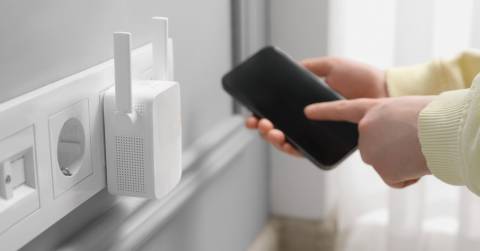The Best Yamaha Av Receivers For 2025

Summary
YAMAHA RX-V385 5.1-Channel 4K Ultra HD AV Receiver
Yamaha RX-V685 7.2-Channel AV Receiver
Yamaha RX-V377 5.1-Channel A/V Home Theater Receiver
Yamaha has been producing all varieties of musical instruments and related accessories for over 100 years, so it's no surprise that so many audiophiles and moviegoers are looking for the best Yamaha receiver these days.
When you visit the official Yamaha website today, you will be astounded by how comprehensive the selection is. You can choose something to fit your demands and budget, ranging from units for average users to advanced receivers with 4-digit price tags. All Yamaha receivers have a distinctive sound, with deep bass and well-defined half-tones.
If you want to buy a receiver made by this company but don't know where to begin your search, this review may be useful. To deliver an honest and unbiased review, we chose the best Yamaha AV receiver and examined its capabilities.
Our Top Picks

You may rapidly set things up using on-screen options Individual speaker volume levels can be configured in a variety of ways Equipped with Dolby and DTS surround sound decoding It lets you enjoy easy wireless music playback from smartphones and other devices.
There are no defined input buttons on the remote
Yamaha's well-received home entertainment systems continue to include it. While it may not have the most up-to-date features, it's an excellent system for an upgrade option.
The RX-V385 was designed with a strong focus on achieving exceptionally high-definition sound. It uses a discrete amp configuration and low-flicker PLL circuitry, contributing to its superb sonic performance.
Bluetooth, Wi-Fi, Airplay 2, Spotify, and music cast are all supported You may operate the receiver with your voice by connecting it to an Alexa device There are two HDMI outputs available Bluetooth connectivity with smart gadgets
There is no lighting on the remote
This Yamaha receiver is an attractive choice for both movies and music, with a wide range of capabilities and high performance at a decent cost. It doesn't have any trouble filling a large area with comprehensive, detailed, and powerful sound.
The receiver is compatible with both new and old service packs, allowing you to enjoy a multi-channel sound system from legacy and stereo recordings.
Surround sound that is both powerful and punchy. Subtle dynamics, accurate placement, and obvious dynamics. On the front panel, there are USB and 3.5mm inputs. Sound control options are excellent.
There are no network features.
The sound and sound settings on this model are what earn it some extra points. It's a five-channel system with superb surround sound. It will produce 100 watts per channel with the possibility of adding more bass. This increased bass does not necessitate the use of large speakers or specialized woofers. It will adequately project lower frequencies through smaller speakers.
The incorporation of the Virtual Cinema Front system is a significant benefit to the sound performance. This enables you to set up five speakers in front of you and still enjoy surround sound. This easily makes it one of the best surround sound AV receivers on the market.
Equipped with a beautiful appearance Sounds interesting when combined with music and film For gamers, it supports the most recent 4K/120Hz input The current feature set and connections
LCD displays can be hard to read.
The Yamaha RX-V6A features a high-speed amplifier that aids in signal transmission accuracy and is well suited to high-resolution audio streams. High-speed amplifiers create signal instability, but Yamaha's novel design circuit accomplishes both high-speed and reliable signal transmission.
The amplifier uses a 384 kHz / 32-bit BB PCM5102A DAC for complete audio conversion.
Allows you to customize the sound to your preferences A simple app can control many objects In movies, there should be a lot of clear speech Wireless connections are flawless.
Voice commands may need the use of an additional device
This Yamaha TSR 700 is the ideal receiver for a home theatre system with seven channels. It is equipped with everything you need to compete with the other Yamaha receivers.
There are many additional options accessible for players and movie enthusiasts alike. This speaker will provide humorous fun to your movie nights, whatever your musical preferences.
Multi-room audio and MusicCast Surround are supported Voice control through AirPlay 2 with Alexa, Google Assistant, etc. Equipped with plenty of choices on how to enjoy your entertainment. It can reproduce big theatre acoustics within the walls of your home.
This one is quite pricey.
We have produced a Yamaha RX-V4A evaluation to help you make your decision. The compatibility for 8K HDMI and 4K Ultra HD footage with full 60p resolution sets it apart from the competition, letting it receive and process 4K information without reduction.
Excellent multichannel audio Support for Dolby Atmos and DTS:X Great when accompanied by music Build quality is outstanding.
Setup is not always intuitive.
The RX-A1080 is a device that demonstrates effectively why you should spend more money on an AV receiver. It has many options, but most importantly, it can display movie soundtracks in their entirety. It is a vital instrument that delivers powerful and immersive movie soundtracks. Music does as well, thanks to the excellent ESS-DAC and amplification.
Add to it the excellent MusicCast platform, and you have an AV receiver that unquestionably warrants the designation "very good."
More To Consider



What Are the Most Critical Aspects of best yamaha av receivers That You Should Concentrate on?
You must know the best yamaha av receivers to make a substantial purchase. There's a slew of additional issues which have to be looked at and assessed. Each commodity has its own set of difficulties. As a result, you can rely on us to give you comprehensive counsel and support.
Through AI and Big Data, this post offers properly reviewed and selected product information. The goal is to provide you with a reliable and accurate set of data.
You might quickly become overwhelmed on your quest for the best yamaha av receivers because there are so many models and features. Avoid being suffocated by an expensive item that only serves to take up room in your cupboard by following our advice.
AirPlay Compatibility
AirPlay is worth it if you have most of your music stored on these devices. You can save money if you don't like the nostalgia, comfort and character of vinyl music, or if you have lots of music on tape or CD, then skip AirPlay.
Network Connectivity And Internet Streaming
Supported Media Formats
Calibration
Automatic speaker calibration is an option on many receivers that makes it easier to calibrate the speakers. The receiver sends test sounds to each speaker and subwoofer, and monitors the sound with a microphone. This allows it to determine the size of the speaker, to measure distance between the speaker and the listener, and to check that the connections are correct. This technology is compatible with surround sound as well as traditional 2-channel home entertainment systems.
Multi-zone Audio Feature
Interface
Power
Total Harmonic Distortion
Auto-calibration Capabilities
Inputs And Outputs
FAQs
What Is The Best Way To Use A/V Receivers With Turntables?
Yes, as long as the turntable has phono input. To boost the low signal coming from your turntable, a preamp will be needed. For entry-level models, preamps are quite inexpensive.
What Is Upconverting In An AV Receiver?
You connect the player to the receiver with one type of connection and expect that the receiver will output the video using another type.
You might, for example, connect an analog DVD player to the receiver and ask it to transmit this via HDMI.
Only the most expensive receivers are capable of upconverting different video inputs to HDMI output. You will need to transmit the component video signal through a component attached to the receiver if the receiver is unable to upconvert.
What Is The Difference Between A Stereo Receiver And A Surround Sound Receiver?
Stereo receivers have two channels, and can be used to play stereo audio. Surround sound receivers have five channels or more and can connect to surround sound speakers.
To get surround sound, most people desire surround sound speakers. Stereo amplifiers can be used to enhance the sound quality in your home.
Is An A/V Receiver Good For Gaming?
You might find it possible, particularly if surround sound is important for immersive gaming. Before you purchase, make sure it supports the most recent standards, such as Dolby Atmos (one of the newer HDMI standards), and HDR compatibility. You can also find features like Auto Low Latency Mode and Variable Refresh rate support on the Denon AVRX4700H. While an A/V receiver doesn't need to be used for gaming, it is a great addition if surround sound is important.
Which A/V Receivers Are Better For Music Or Movies?
No. No. Music can reveal more about sound quality and character than movies soundtracks. Those who listen to music may prefer one brand over another.
Does An AV Receiver Improve Video Quality?
Advanced video processing abilities can be found in some AV receivers that improve image quality. The best performance is only possible with high-end, expensive models.
Even if your receiver is not high-end, modern televisions are equipped with excellent video processing algorithms, which will produce a stunning picture, regardless of source.
What Is The Difference Between 5.2 And 7.2 Receivers?
Five surround sound speakers can be connected to a 5.2 receiver, as well as two subwoofers. For the surround sound speakers, there are five options: front left, front right and center.
Seven channels are available for surround sound speakers, and two subwoofer channels. A 7.2 receiver can handle both. The 7.2 speaker arrangement is identical to a standard 5.1 setup, with two additional surround sound speakers at the back and one more in the back.
Does An AV Receiver Need An Amplifier?
No. A AV receiver can be equipped with an amplifier that will power your speakers.
What Is The Difference Between An AV Receiver And An Amplifier?
An integrated amplifier that includes a preamplifier as well as a power amp in one box is called an AV receiver. It is also known as a receiver. It could be called an amplifier.
A receiver can be described as an integrated amplifier and a tuner that receives AM/FM radio signal. Technically speaking, an AV amplifier should not be used if it doesn't include a tuner. An AV receiver can be used, but it is still a common term.
After all, it's time for you to pick up your buddy based on the things above. Don't waste your time at any unreliable site. As mentioned above, our website includes not only interesting information but authoritative one, so that you should come to us as regularly as possible.
We always welcome your feedback, whether positive or negative, since all of them will contribute to improving our site. Please join us for better service and wish you a cherishing shopping!


















